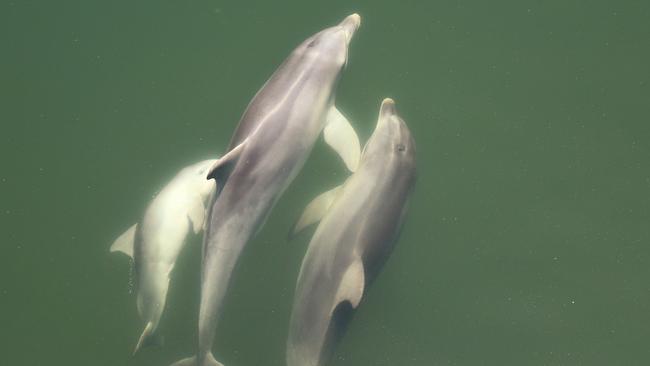Adelaide Dolphin Sanctuary investigation’s first report on health of Port River pod
An investigation has revealed what may have killed five young dolphins in the Port River pod – and researchers point the finger at more than one factor.
SA News
Don't miss out on the headlines from SA News. Followed categories will be added to My News.
Port River pollution is making dolphins susceptible to illness that limits their hearing and their ability to hold their breath, making them more likely to be struck by boats, a study has found.
A South Australian Research and Development Institute report delves into details of the pod’s decline.
While no clear cause has yet been found for the death or disappearance of five young males between June and November last year, the researchers describe a depressing series of threats.
The report says factors including an accumulation of toxins – as well as infections, injuries and reduced prey availability – leave their immune systems weakened.
That allows parasites to take hold in their lungs that “may reduce breath-hold capacity”.
“Parasites in the auditory system could reduce hearing,” the report says.
“Both these conditions could increase the chance of vessel collisions. Thus, death by vessel collision could result from a pathway of predisposing conditions.”
When six-year-old Hunter was controversially euthanised on last October, he had poor vision, a severe bacterial ear infection, multiple infected skin lesions, damaged lungs, an inflamed bleeding stomach and inflamed small intestine. He was emaciated and starving.
His younger brother Squeak, 4, died a month later from “blunt trauma” but also had skin abscesses, had been losing weight and had been eating an unusual diet.
These deaths followed the disturbing disappearances of Doc last June and Twinkle last July, after they became thin and weak. Tallula was found dead in a similar condition in August. Tallula’s autopsy also found a fish hook in his stomach, enlarged adrenal glands, depleted white blood cells, toxoplasmosis (a parasite infection commonly found in cats), mouth ulcers and dermatitis.
The SARDI report’s lead author Dr Roger Kirkwood told the Sunday Mail it was possible that young males accumulated higher levels of toxins in their bodies because females were detoxified by the process of birthing and raising infants.
The report concluded that the dolphins suffered from “stress, a level of immune suppression, and compounding factors including … diseases … (that) cause deterioration in condition and organ function, with subsequent starvation”.
“The ultimate cause of death may be distant from the factors leading to ill-health,” the report said.
It suggested that future monitoring and research would be needed to help clarify the pod’s status.
Environment Minister Susan Close said it was “disappointing that the study has to date failed to identify the (definitive) reason for the unexplained dolphin deaths”.
“I note that a further study with Flinders University is occurring and I have asked the (Environment) Department to accelerate this work as much as possible, given the ongoing concerns about the resident dolphin population,” she said.


Jenni Wyrsta of the volunteer organisation Port River Dolphin Watch said she wished dolphins could receive greater care and medical attention in the sanctuary and would prefer if the Australian Marine Wildlife Research and Rescue Organisation was given the authority to intervene.
“I think the main threat to all the dolphins in the sanctuary is the current attitude to wait and see if sick dolphins can heal themselves, which more often than not, results in dolphins suffering and slowly starving to death,” she said.
“This attitude should be replaced by speedy intervention to treat the sick dolphin where possible.”





